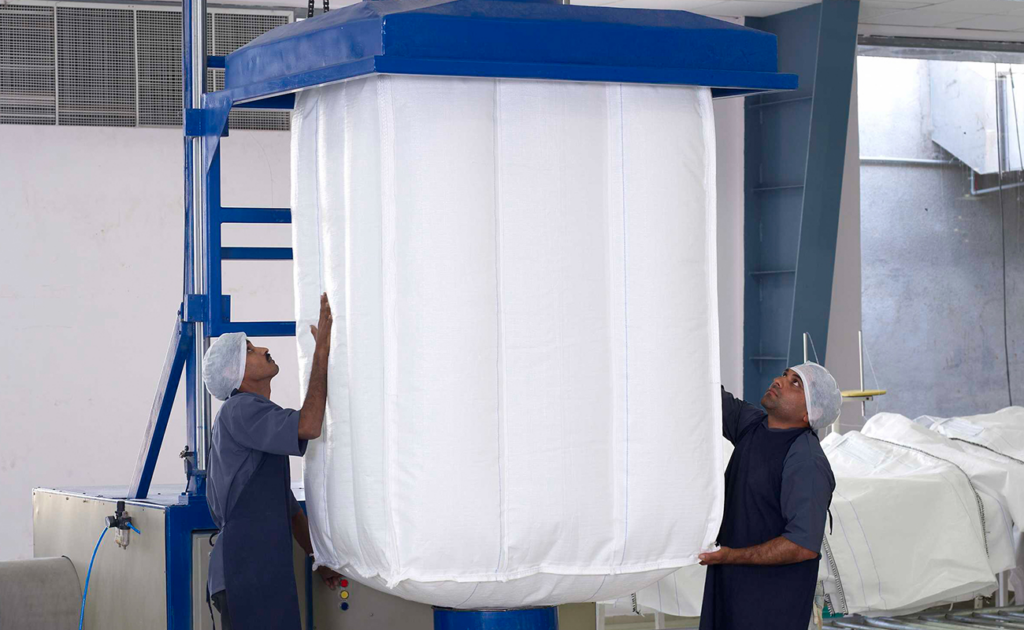Flexible Intermediate Bulk Containers (FIBC) bags, often known as bulk bags or jumbo bags, have become an essential part of the modern industrial packaging and transportation landscape. These bags are designed to store and transport large quantities of bulk materials efficiently and safely. With various types available, each designed for specific uses, it’s essential to understand the different kinds of FIBC bags and how to choose the right one for your needs.
In this blog, we will explore the different types of FIBC bags, their construction, and the best applications for each type.
What Are FIBC Bags?
Before diving into the specifics of the various FIBC bag types, let’s take a quick look at what makes these bags so valuable. FIBC bags are large containers made from woven polypropylene or similar materials. They are designed to carry and store dry, flowable products like grains, chemicals, or powders. The bags are equipped with lifting loops that enable easy loading and unloading, making them a popular choice in industries such as agriculture, construction, and chemicals.
These bags come in different sizes, shapes, and construction methods, each tailored to specific products and handling requirements. Now, let’s break down the various types of FIBC bags and their uses.
Types of FIBC Bags
explores the various categories of flexible intermediate bulk containers, each designed to meet specific material handling and safety requirements. Understanding these types ensures you select the best option for your storage and transportation needs.
1. Standard FIBC Bags (Type A)
Type A FIBC bags are the most basic and commonly used type. These bags are made from polypropylene fabric and are non-conductive, meaning they cannot prevent static electricity. Type A bags are primarily used for non-flammable, dry materials that do not pose a risk of explosion due to static buildup.
Best Uses
- Agricultural Products: They are commonly used in the agriculture industry for storing grains, cereals, and other dry food products.
- Construction Materials: These bags are also ideal for carrying building materials like sand, soil, and cement.
- Non-flammable Chemicals: Type A bags can be used to transport various non-flammable chemicals that don’t generate static charge.
2. Conductive FIBC Bags (Type C)
Type C FIBC bags are designed to handle potentially hazardous materials where static electricity may pose a risk. These bags are woven with conductive threads that allow the static charge to dissipate safely. Unlike Type A bags, Type C bags must be grounded when in use to ensure that static charges are properly neutralized.
Best Uses
- Flammable Materials: Type C bags are best suited for carrying flammable or explosive powders, such as chemicals or flour, where the risk of static-induced ignition is present.
- Electronics Manufacturing: These bags are commonly used in industries where electronic components or volatile materials are stored.
- Chemical Industry: For safely transporting chemicals that could react to static electricity, Type C FIBC bags are a safer choice.
3. Non-Conductive FIBC Bags (Type B)
Type B FIBC bags are made from woven polypropylene fabric and are designed to prevent the buildup of static charges. However, unlike Type C bags, they do not feature conductive threads. These bags are suitable for transporting non-flammable materials where static discharge may not be a significant concern but still need to be minimized.

Best Uses
- Flammable Liquids: Type B bags are often used to store materials like certain chemicals, solvents, or powders that may be sensitive to static but do not have a high risk of ignition.
- Dry Goods: They are frequently used in industries dealing with dry goods such as sand, grains, and minerals, where static buildup could potentially cause minor disruptions but does not present a direct threat.
4. Type D FIBC Bags (Anti-Static FIBC)
Type D FIBC bags are the most advanced in terms of static control. These bags are made from materials that are inherently conductive, designed to dissipate static charges safely even without the need for grounding. They are built to handle highly flammable products or environments where the risk of ignition is extremely high.
Best Uses
- Highly Flammable Materials: Type D bags are ideal for transporting highly flammable powders and chemicals, especially in industries such as pharmaceuticals, food, and electronics.
- Explosive Environments: In industries where explosions could result from static buildup, such as chemical or pharmaceutical production, Type D bags are crucial for maintaining safety.
- Sensitive Electronics: These bags can also be used for packaging delicate electronic components that are prone to damage from static discharge.
Features to Consider When Choosing FIBC Bags
While the type of FIBC bag you choose will depend on the materials you are storing or transporting, several other key features should also be taken into account when making your selection.
1. Bag Strength and Load Capacity
FIBC bags come in various strengths, usually measured in terms of their safe working load (SWL). It’s crucial to choose a bag with a weight capacity that aligns with the materials being transported. Standard FIBC bags typically have capacities ranging from 500 kg to 2,000 kg, but heavy-duty bags can carry much larger loads.
2. Fabric Construction
The construction of the bag’s fabric is another important factor. FIBC bags are primarily made from woven polypropylene, which provides strength and durability. However, some bags come with extra features such as UV-resistant coatings for extended outdoor use or extra reinforcement in high-stress areas for added longevity.
3. Liner Options
Some FIBC bags come with an internal liner that provides additional protection for sensitive products. These liners can be made from polyethylene, which helps prevent contamination and moisture ingress. Choosing a bag with a liner is essential if your product is sensitive to environmental factors like moisture or dirt.
4. Custom Features
FIBC bags can be customized in several ways, depending on the specific needs of your industry. Custom features may include:
- Printing: FIBC bags can be printed with company logos or specific labeling information for easy identification.
- Lifting Loops: Some bags come with additional lifting loops or different loop configurations for easier handling.
- Top and Bottom Closures: Depending on your application, FIBC bags can be designed with various types of closures, such as drawstring or spout top, to prevent spillage and ensure safety during transport.
Best Practices for Using FIBC Bags
To ensure the safe and efficient use of FIBC bags, it’s essential to follow a few best practices:
1. Inspection and Maintenance
Always inspect FIBC bags before use to ensure they are in good condition. Check for any signs of wear, tears, or damage. After use, make sure to properly clean and store the bags to prolong their lifespan.
2. Proper Loading
When loading FIBC bags, avoid overfilling to prevent strain on the bag. Ensure that the load is evenly distributed, and do not stack bags too high unless they are designed to be stacked.
3. Grounding Type C Bags
If you’re using Type C FIBC bags, remember to ground the bags properly to discharge any static buildup. Failure to ground the bag can result in static discharge, which could potentially lead to an explosion or fire.
Conclusion
FIBC bags are a versatile and essential packaging solution for a wide range of industries. Understanding the different types of FIBC bags and their applications is crucial for selecting the right bag for your needs. From standard FIBC bags to more specialized types like Type C and Type D bags, each offers distinct advantages depending on the materials you’re handling and the level of safety required.
By choosing the correct FIBC bag type and following best practices, you can ensure the safe, efficient, and environmentally friendly transport of bulk materials. Whether you’re working with agricultural products, chemicals, or pharmaceuticals, there is an FIBC bag that is perfectly suited for the job.
